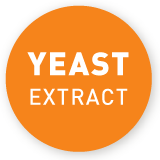Food analyst Professor Ursula Bordewick-Dell from the University of Applied Sciences of Münster provides a more precise insight into the various components that make up natural yeast extract, which is responsible for creating that unique umami taste.
“To ascertain which individual components make up yeast extract, it is worthwhile first taking a closer look at the production of yeast extract,” explains the expert. “This takes place in three stages: to encourage the yeast to grow, it is first fermented, which means sugar is added to the yeast fungus to nourish it. The yeast is then concentrated and washed in centrifuges. This process removes any sugar residues. What remains is a so-called ‘suspension’, a viscous, creamy mass of yeast. The next stage is autolysis, whereby enzymes present in the yeast split the yeast proteins and other macromolecules into smaller molecules. The cell walls of the yeast cells are dissolved at the same time. The result is a liquid that has a similar profile of amino acids to a meat-based stock. The taste of yeast extract also resembles that of a meat-based stock due to the similar composition of proteins and amino acids. A centrifuge is also involved in the final stage, which removes the remaining cell walls. The end result is yeast extract, which retains the valuable proteins, vitamins and minerals from the original yeast cells. In essence, yeast extract is therefore simply made up of the natural components of a yeast cell – but without the surrounding cell wall.”
The unique, savoury natural flavour and the ability to improve the taste of a dish with completely natural components make yeast extract a popular ingredient in sauces, soups, dishes and snacks – for conventional cuisine as well as for vegan or vegetarian dishes. In the UK and in Australia, yeast extract is also the main component of extremely popular sandwich spreads.



